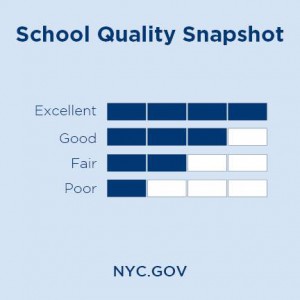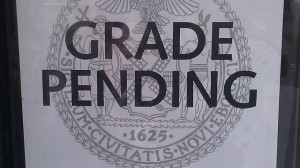
DOE Overhauls School Grades
NYC DOE overhauls school grades
 On Tuesday, Chancellor Farina announced a new ratings system.
On Tuesday, Chancellor Farina announced a new ratings system.
Listen to this post!
(UPDATE: This is a corrected post. We had previously attributed the elements of the School Quality Guides as the Capacity Framework. We apologize. The Framework is actually this.)
Here is the breakdown:
- Test scores mean less
- Schools measured by strength of curriculum
- school environment matters
So are the letter grades over?
Yes.
Listen to the WNYC Story
“It makes things much more transparent, and it actually gives a lot more information both to parents and to staff about where they need to move and how they need to move,” Ms. Fariña said. “We are looking beyond test scores and focusing on making sure that each school has what it needs for sustained and continuous growth. And we have developed a framework that mirrors the essential elements we see in schools that continually improve.” (From Beth Fertig, WNYC)
New Letter Grades
The DOE released this statement: Students aren’t a single letter grade. And neither are schools.
Introducing the School Quality Snapshot, a common sense, balanced look at a school’s achievement that recognizes that students learn and display knowledge in different ways.
Here’s a look at the new Snapshot.
What does this change?
 Under the old system, instituted under Mayor Bloomberg in 2006, schools received annual progress reports. Those reports included an overall A-F letter grade, as well as separate grades in four categories:
Under the old system, instituted under Mayor Bloomberg in 2006, schools received annual progress reports. Those reports included an overall A-F letter grade, as well as separate grades in four categories:
- student progress
- overall student performance
- the school environment (based on attendance rates and the results of an annual survey of students, parents, and teachers)
- improvement made by the lowest performing students, by English language learners and by students with disabilities
For elementary and middle schools, 85 percent of the overall letter grade was based on test scores.
This report, in conjunction with the yearly quality review by a superintendent, which assessed collaboration and instructional quality, determined school closings
So How Will The New School Grades Look?
- for parents — this will be the School Quality Snapshot
- for educators — The School Quality Guide
The snapshot ranks schools from POOR to EXCELLENT, and compares it to city averages.
The Quality guide goes into more depth, showing trends over the past three years, and replacing A-F letters with “Not meeting target,” “Approaching target,” “Meeting target” and “Exceeding target.”
Is this really a big shift?
This is a 180-degree flip from the quantitative approach of the previous administration. In gearing themselves toward a more holistic approach, schools leadership is gearing up for the chancellor’s vision, announced this week: Capacity Framework.
(UPDATE: This is a corrected link. We had previously attributed the elements of the School Quality Guides as the Capacity Framework. We apologize. The Framework is this.)
Capacity Framework?
The Capacity Framework is a research-based, collaborative model for a #GreatNYCSchools future built on six essential elements.
Read more about Chancellor Fariña’s vision. We’ll have a post soon, outlining what it means.
For now, the Chancellor is stressing the importance of the administration’s collaboration with schools, teachers, and parents. “This is a new era in education in New York City,” she added.”We are no longer forcing change on people, we’re creating change with people.”
So, What will the School Quality Guide Measure?
In brief, the elements look like this:
- Quality Review: a formal evaluation of the school by an experienced educator who visited the school, observed classrooms, and spoke with parents, students and school leaders
- Student Progress: for elementary and middle schools, student improvement on the State tests in English and math, compared to other students who scored at the same level last year; for high schools, progress students make towards graduation by accumulating credits and passing Regents exams
- Student Achievement: for elementary and middle schools, student performance on the State tests in English and math and course pass rates (middle school only); for high schools, graduation rates after four and six years
- School Environment: parent, student and teacher satisfaction levels with the school’s learning environment, as reported in the NYC School Survey, as well as student attendance
- Closing the Achievement Gap: significant gains with English Language Learners, students with disabilities, and students who scored in the lowest third citywide on State tests last year; movement of students with disabilities into environments with non-disabled peers
- College and Career Readiness: for high schools, student readiness for college and careers, based on their achievements in high school and their outcomes after leaving high school
UFT Reaction
“The previous letter grades were misleading. They were based on test scores so education became nothing more than test prep,” said Michael Mulgrew, President of the United Federation of Teachers. “Now we will have a way of showing what really makes a great school: top-notch instruction, effective leadership and a supportive environment that children, parents and teachers can trust.”
So, is this a move to de-emphasize testing?
That’s what the Chancellor has said she wants to do, and this could be the first big step.
This is a big push from the DOE!
It is. And it’s happening right when charter schools are about to denounce the state of NYC public schools, in an effort to cast the public schools as a system that fails to serve students well, in particular students in low-income areas of the city.
Stay tuned for that.
For further reading, check out the Chalkbeat post here.
CITE is the Center for Integrated Training and Education . For over 25 years, CITE has and continues to train TEACHERS (Early Childhood, Literacy, Special Ed, Grad Courses, DASA); COUNSELORS (School, Mental Health Masters, Advanced Certificate); and ADMINISTRATORS (SBL, SDL, Public Admin, Online PhD) in all five boroughs of NYC, Yonkers, and Long Island.
What question can we answer for you? 877-922-2483



